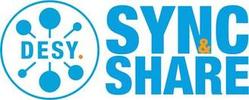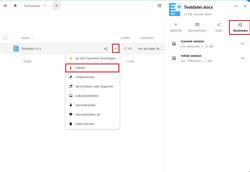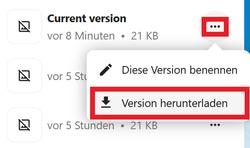URL: https://it.desy.de/services/storage_services/desy_sync__share/index_eng.html
Breadcrumb Navigation


|

|
|
|
|
Instructions and Information
If you are interested, please click on the tiles below to learn more about the topics.
Frequently Asked Questions
Information about Login / Logout
How do I login to the web site of DESY Sync & Share?
After opening the web site, you will be redirected temporarily to the login service Keycloak (keycloak.desy.de).
Please note: You may receive a notice that the service wants to use a certificate for login when you first access the page. If you receive such a request, please decline it.
Step 1 - Login with the DESY-Account
First, log in with the desired DESY account by entering the user name and the corresponding password (1). Then confirm by clicking on "Sign in" (2).
Step 2 - Enter the 6-digit one-time password
In the next window, please enter the 6-digit one-time password of your token (1) and confirm the login by clicking on "Sign in" (2).
Afterwards, if your login was successful, you will be redirected to the cloud service.
How do I logout from Nextcloud Client?
|
|
Example: Windows |
|
|
Main Screen of the Nextcloud Client |
How can I login with my Smartphone / Tablet on the Nextcloud Client?
The Nextcloud client is also available for smartphones and tablets. You can read how to set it up here.
How do I create a so called App Password for a WebDAV Connection?
|
An App Password is needed for the connection to the Sync & Share service using WebDAV. In this case, use the app password instead of your account password. The general instructions for setting up a WebDAV connection can be found here.
|
||
|
Figure 1 |
Figure 2 |
|
|
||
|
Figure 4
|
||
General Information
What is my advantage of using DESY Sync & Share ?
You have the possibility to save, synchronize or share your data in a known dropbox-like system with the advantage to store the data securely on DESY storage devices. This means that your data is physically stored here at DESY and not at another company's computer centre.
How much data can I store ?
Unlimited storage space is available to you in DESY Sync & Share. Our aim is not to use a quota.
You are able to upload max. ~10GB per file using the web interface. The official Nextcloud sync client has a default limitation of 500 MB per file, but can be enlarged or reduced in the sync client via menu item "General". Using the installed Nextcloud client / WebDAV you may upload files which are larger than 10GB.
What type of data can/should I store in my cloud?
In general, you can store any kind of data in the cloud, there are only a few small things to consider here.
You have to be aware that if you store a lot of small data packets in the cloud (like a lot of small measurement data), the synchronization process may take longer and, if there is not enough disk space available locally, it takes away the disk space on your device.
Can I use DESY Sync & Share for my private data?
The terms of use and policies for Desy's own resources, whether it is a screwdriver, your DESY phone or data storage, are described in your private contract and in Desy's Master Works Agreement (Gesamtetriebsvereinbarung).
Since we do not want to go into detail, please make yourself familiar with these legal documents.
As a rule of thumb, however, you can assume that the private use of DESY's own resources is not very welcome.
How can I get access to DESY Sync & Share ?
To use DESY Sync & Share, please contact the UCO (uco@desy.de or Tel.: 5005) or your namespace administrator.
After allocation of a necessary ressource you can log in here syncandshare.desy.de
Access to files and synchronization
How can I access the data in my cloud?
1. via web interface
2. via sync-client
3. via WebDAV
Can I also access my data from outside of Desy?
Yes, you can access DESY Sync & Share from outside the same way as from inside.
Which Sync-Client should be used?
Basically, the Nextcloud Sync-Client should be used in the newest version.
How does the Sync-Client work and how can I synchronize a local folder with the cloud?
The DESY Sync & Share sync-client works bidirectionally. So there is the possibility to synchronize a locaal folder on your own computer with a folder in the cloud. The contents of the folders are always synchronized with each other.
If for example the folder should be empty on the computer, but full of data on the cloud, this data is copied to the empty local folder.
If two files have the same name and there is a conflict, the client will ask which file should be overwritten.
A synchronized folder is configured in the client via Settings -> Click on your own name -> Add Folder Sync Connection. Then choose a folder on the computer which you want to synchronize with a folder in the cloud.
Data protection and security
Who has access to my DESY Sync & Share?
Only the system administrator has access to your data, but he will only see your data if there are unexpected problems or if this is expressly requested by you.
And of course the people you shared data with, but only the data you shared, not the entire cloud.
How should I handle confidential/ personal data with DESY Synk & Share?
If you share confidential/personal data about DESY Synk & Share , we recommend to provide the link with password and expiration date.
If you share confidential/personal information with Desianers, you can also set an expiration date here. There is no need to give a password because the data is shared directly with the account of the person, who works for or at Desy.
Is my data encrypted in the cloud?
We only encrypt your data during transmission (end-to-end encryption). The stored data is not.
There are, however, various software from third-party providers that encrypt your data in advance and you can then store it on the cloud. For further information please contact the UCO or D4.
Is my Cloud data backed up?
No and Yes.
No, because we are not, and won't in the future, run a traditional backup over our cloud file system.
To understand the "yes" we need to recall what functions are subsumized under the term "backup".
Firstly, file system backups are essential to recover from data loss caused by system failures including succsessful hacker attacks or physical desasters.
How is this covered by our cloud?
Our cloud system, as based on dCache, is creating three copies of your data on different, physically distinguished storage devices. While the second copy is basically created to overcome regulare disk failures, frequently happening in the cause of normal computer center operations. The third copy is made on a custodial device, logically and physically separated from the core system.
What does that mean?
Physically, the custodial storage system is not located wihin the premises of the DESY computer center but in a different building. Logically, the custodial system only permits a restricted set of operations submitted by the core system, which is only read and write. In other words, the core system, has no technical possibility to overwrite or remove data within the custodial system.
Therefor system malfunctions, resulting in accidentally removal of data in the core system, won't and can't technically being forwardedto an external custodial system. Consequently those copies are safe from core system malfunctions. So we think that with those measures, we covered pretty much any system malfunction or disaster we are aware of.
The second duty of a traditional backup system is to protect your storage space from yourself, as it can always happen that you accidentally overwrite or remove your precious data. In those cases, our cloud system provides you with two protective mechanisms, you may know from other operating systems, to tackle those kind of mishaps. Whenever you remove a file in our storage cloud, the file is actually not really removed from any physical device but instead the file entry is moved from your directory space into your trash folder. There it stays for a while, in general 180 days, giving you the chance to move it back into your regular file system space, should it happen that you change your mind, as already described under "What happens if a file or folder is deleted".
In case you overwrite your file or you modify your file and would like to restore a previous version, the system provides you with a versioning functionality. Please check the Question "What's the deal with the versions"!
Coming back to the original question; Yes, we think we provide you with all the benefits of a traditional backup system w/o actually runing such a thing:
Continous data protection
- data los by system
- unintended data modification and deletion by user. (Version and Trash)
- According to DESY policy: 180 days after final deletion.
- File on tape can only be deleted by TSM, NOT by dCache.
- No user Level Restore from tape, - Trash and Versioning
- Tape copy is in different building.
Is my cloud data vulnerable to hacker attacks?
First of all, Yes, your cloud data is! But all software is in principle vulnarable to hacker attacks.
So, your data is as secure as your DESY-password and we gguarantee installation of security patches as soon as available.
Sharing with others
Can I share my data with non Desyaners?
Yes you can, as this is described on the page linked below:
<First Steps with DESY Sync and Share>
Can I revoke shared data?
Yes, any kind of Shares, i.e. data shared by and with you, can be revoked. Please note, however, that the shared data may already have been copied. There is no resetting a revocation, if the share was unintentionally revoked, it must be redo from destination to destination.
What happens if a file or folder is deleted?
What's the deal with the "versions"?
These version files can be viewed by clicking on the three dots and then by clicking on "Details" and "Versions" (see Figure 1).
Under "Versions" with a click on the three dots you can restore an older version ("Restore version") or you can download the version file of an older version directly without having to restore that version ("Download version") (see Figure 2).
What is the Federated Cloud ID and how do I find it?
With the Federated Cloud ID you can share files on other NextCloud servers. The files appear to the other user as if they were on his server.
To share files / folders with another user, click on the share icon and enter the users Federated Cloud ID (on the other NextCloud server) in the right field (in the form: username@cloud.example.de).
You can find your own Federated Cloud ID by clicking on the user icon (letter of the last name on it) in the cloud interface at the top right, going to settings and then clicking on "share". There you can find the Federated Cloud ID in the form username@sas.desy.de. You can then forward these to the other user.
With your own Federated Cloud ID you can also import public shares (links) into your cloud (if they have not been imported automatically): Type the link that you received into the field "direct link" after clicking on the menu bar at the top right.
Now type in your Federated Cloud ID unterneath and confirm everything. A notification appears at the top right and you only have to accept this share.
Will there be regularly announced maintenance times?
Yes, initially we expect 4 -6 sheduled downtimes per year. Certain security system updates can be done in with roling updates, no user noticing.
However, critical security or data integrety updates might become necessary and may not be possible with RU.
Troubleshooting
My data in the cloud disappeared!
It might happen, that you suddenly find that a file or a set of files, you are sure you wrote into the cloud system, is no longer available in the cloudfile system. In those cases we are of cause more than happy to find your data again.
However, er would ask you to run through a small checklist in order to help us to help you.
Firstly, please try to remember if this cloud was actually the system you used to upload that particular file to. In case that's confirmed, please check your trash folder, as you might removed the file yourself.If that doesn't help you either please try to remember if the missing file was actually a share from another cloud user which he or she could have removed recently without telling you. In that case you would need to contact that person to restore the share.
If none of these checks apply, you are more than welcome to contact the DESY User Consulting Office (UCO@desy.de Tel.: 5005). Doing so, it would be extremly helpful if you could provide us with some basic information helping us to track down your precious data, like filename, the directory, your account-name, your remember holding the data and if possible the day/week/month you initially uploaded that file to the cloud. UCO will come back to you as soon as we figured the cause of the incident.
I cannot accept shares (Failed to perform action)
When accepting file shares, an error message might appear saying "Failed to perform action".
This usually only happens when trying to accept or decline federated shares, that means receiving files from users on other servers (e.g. XFEL Cloud).
To accept these shares, you have to navigate to the domain which the share was sent to, usually it is https://syncandshare.desy.de.
Should you still not be able to accept the share, please contact the UCO.
Whom do I have to contact in case of problems?
In case of problems please send an email to UCO@desy.de
or you can also contact us by phone at 040-8998-5005.
My document is damaged and cannot be repaired!
If one of your files or folders is damaged and cannot be repaired, you can restore an earlier version of this file/folder.
Follow our steps to be able to use the file again:.
- Log in to https://syncandshare.desy.de
- Navigate to the file or folder and open the file/folder details. To do this, click on the three dots on the right-hand side of the file name.
Important information for administrators
|







